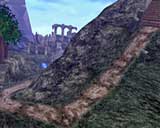 It always takes a long time for a new console system to come out
with it’s first great RPG, but it’s a gold mine once they finally do. Final
Fantasy VII made a mint and single-handedly sold about a bijillion PlayStations, and you
better believe that little tidbit of information is tucked away in the minds of game
developers and Sega executives everywhere, to say nothing of Dreamcast owners everywhere,
who have been foaming at the mouth in anticipation of an RPG since they first saw what a
next generation system could do.
It always takes a long time for a new console system to come out
with it’s first great RPG, but it’s a gold mine once they finally do. Final
Fantasy VII made a mint and single-handedly sold about a bijillion PlayStations, and you
better believe that little tidbit of information is tucked away in the minds of game
developers and Sega executives everywhere, to say nothing of Dreamcast owners everywhere,
who have been foaming at the mouth in anticipation of an RPG since they first saw what a
next generation system could do.To fill the gap between console launch and epic RPG
launch, gamers are generally hit with a slew of mediocre games that aren’t designed
to make waves, but to capitalize on gamers' hunger and satiate their RPG desires until the
real games come out. Unfortunately, Time Stalkers definitely isn’t the epic success,
and it’s not even very satisfying.
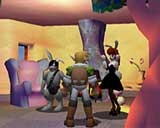 You
play Sword, who is mysteriously transported to another time/dimension when he opens a
magical book. He is cast into a piece-meal floating-land-mass populated with other such
outcasts who had the same experience and were taken from their respective planets. An old
wise man immediately dubs Sword a hero and even gives him a hero crest to prove it. Sword
then proceeds to solve various problems and vanquish various foes while following a story
that only qualifies as such by the most liberal definition of the word.
You
play Sword, who is mysteriously transported to another time/dimension when he opens a
magical book. He is cast into a piece-meal floating-land-mass populated with other such
outcasts who had the same experience and were taken from their respective planets. An old
wise man immediately dubs Sword a hero and even gives him a hero crest to prove it. Sword
then proceeds to solve various problems and vanquish various foes while following a story
that only qualifies as such by the most liberal definition of the word.
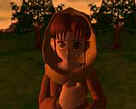 Sword’s
world initially consists of an area roughly equal to a city block, and gets a little
bigger as land gets sucked into the new dimension and tacked on. To say that the world is
small is a severe understatement. Located throughout the small floating landmass are
various dungeons that have to be cleared in order to progress through the
"story".
Sword’s
world initially consists of an area roughly equal to a city block, and gets a little
bigger as land gets sucked into the new dimension and tacked on. To say that the world is
small is a severe understatement. Located throughout the small floating landmass are
various dungeons that have to be cleared in order to progress through the
"story".
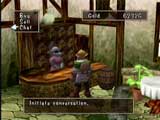 Graphically, Time Stalkers disappoints. It fails to harness the power of the
Dreamcast and looks instead like a very good PlayStation game. The character models are
just plain ugly, and their exceptionally large joints make them look a lot like
marionettes. The monsters suffer a similar problem; they have little detail, and not
enough variety. Time Stalkers uses randomly generated dungeons under the guise of
"infinite replayability." This might be an excellent device if you were playing
Pac Man, but in an RPG the focus should be on quality rather than quantity. The randomly
generated dungeons look uninspired and repetitious as you travel through level after level
of unchanging, unengaging scenery. The surface world is the one area that shows graphical
prowess, as the buildings look great and you are treated to a variety of wacky things like
a landmass that floats on the back of a giant floating turtle. Unfortunately the area is
obscenely small and little time is spent in it, usually just long enough to pass through
on your way to another boring dungeon.
Graphically, Time Stalkers disappoints. It fails to harness the power of the
Dreamcast and looks instead like a very good PlayStation game. The character models are
just plain ugly, and their exceptionally large joints make them look a lot like
marionettes. The monsters suffer a similar problem; they have little detail, and not
enough variety. Time Stalkers uses randomly generated dungeons under the guise of
"infinite replayability." This might be an excellent device if you were playing
Pac Man, but in an RPG the focus should be on quality rather than quantity. The randomly
generated dungeons look uninspired and repetitious as you travel through level after level
of unchanging, unengaging scenery. The surface world is the one area that shows graphical
prowess, as the buildings look great and you are treated to a variety of wacky things like
a landmass that floats on the back of a giant floating turtle. Unfortunately the area is
obscenely small and little time is spent in it, usually just long enough to pass through
on your way to another boring dungeon.
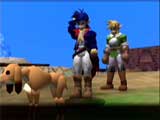 Some of the greatest RPG’s of all time have succeeded despite bad graphics
because of their stellar gameplay, but Time Stalkers comes up way short in that department
as well. The most fundamental aspect of an RPG is a sense of advancement and progress. The
protagonist is a little wussy boy fighting the good fight, who gradually gains more and
more power as the game goes on. The player is rewarded for his vigilance with a badass
warrior who can smack talk all the monsters he finds, develops cool looking special
attacks, and uses them to whoop up on evil. Time Stalkers has replaced this time honored
system with a frustrating, nonsensical pattern of constant advance and retreat. You enter
a dungeon at level one, and an hour later when you’re facing the dungeon's boss you
will be around level fifteen to twenty. When you defeat the boss you will exit the dungeon
and be demoted to level one again. You can earn titles for your work in the dungeon which
can slowly earn you new abilities, but you are still reduced to a shadow of your former
glory with a fraction of the ability scores and hit points. You then find another dungeon
and repeat the process. This is, quite simply, lame. Did Aragorn whoop up on a bunch of
orcs only to turn into a wuss for a week afterwards? Did Luke Skywalker start fighting
like a little girl after he whooped ass on the Rancor? No, he found bigger things to go
chop up with his lightsaber. That’s what heroes do. Time Stalkers offers little sense
of progress or advancement and without that the player is hard pressed to find a reason to
continue playing the game.
Some of the greatest RPG’s of all time have succeeded despite bad graphics
because of their stellar gameplay, but Time Stalkers comes up way short in that department
as well. The most fundamental aspect of an RPG is a sense of advancement and progress. The
protagonist is a little wussy boy fighting the good fight, who gradually gains more and
more power as the game goes on. The player is rewarded for his vigilance with a badass
warrior who can smack talk all the monsters he finds, develops cool looking special
attacks, and uses them to whoop up on evil. Time Stalkers has replaced this time honored
system with a frustrating, nonsensical pattern of constant advance and retreat. You enter
a dungeon at level one, and an hour later when you’re facing the dungeon's boss you
will be around level fifteen to twenty. When you defeat the boss you will exit the dungeon
and be demoted to level one again. You can earn titles for your work in the dungeon which
can slowly earn you new abilities, but you are still reduced to a shadow of your former
glory with a fraction of the ability scores and hit points. You then find another dungeon
and repeat the process. This is, quite simply, lame. Did Aragorn whoop up on a bunch of
orcs only to turn into a wuss for a week afterwards? Did Luke Skywalker start fighting
like a little girl after he whooped ass on the Rancor? No, he found bigger things to go
chop up with his lightsaber. That’s what heroes do. Time Stalkers offers little sense
of progress or advancement and without that the player is hard pressed to find a reason to
continue playing the game.
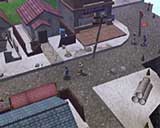 While
you have a variety of characters you can take adventuring, you can only have one in your
party at a time. The other two spots are filled with monster allies that you have captured
on the course of your adventuring career. This boils down to having one cool character and
two generic and shallow ones in your party at a time. Why? If you're going to use a party
system in the first place, why not have a party full of interesting characters, especially
since all those characters are already in the game? Every RPG in history that has used a
party system has executed it more successfully than Time Stalkers. The monster allies are
boring characters that can do nothing more than attack and be attacked, while the
barbarians and wizards sit at home and wait to be tagged in.
While
you have a variety of characters you can take adventuring, you can only have one in your
party at a time. The other two spots are filled with monster allies that you have captured
on the course of your adventuring career. This boils down to having one cool character and
two generic and shallow ones in your party at a time. Why? If you're going to use a party
system in the first place, why not have a party full of interesting characters, especially
since all those characters are already in the game? Every RPG in history that has used a
party system has executed it more successfully than Time Stalkers. The monster allies are
boring characters that can do nothing more than attack and be attacked, while the
barbarians and wizards sit at home and wait to be tagged in.
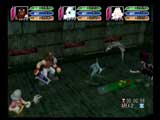 You
cannot enter a dungeon with more than four items, so even though you will find a variety
of items and equipment, most of it will have to be used before you leave the dungeon. In
addition, more powerful items require a high level to use. Since you begin each dungeon at
level one, you will have to allot some of your precious four slots to weapons, armor, or
items that you won’t be able to use until later in the dungeon. You will soon have a
storehouse full of weapons and items that can’t be used, and can’t even be
brought into the dungeon with you. You can sell them, but you can’t use the money to
buy better stuff because the stores offer little of interest. While shopping is sometimes
one of the greatest parts of an RPG, I don’t think I ever bought anything at all from
the store in Time Stalkers, which offers only basic equipment that is obsolete almost
immediately. The only remaining avenue to spend money are a few of the more exotic shops
that appear later in the game that allow you to purchase VMU games. This had potential,
but was too little, far too late.
You
cannot enter a dungeon with more than four items, so even though you will find a variety
of items and equipment, most of it will have to be used before you leave the dungeon. In
addition, more powerful items require a high level to use. Since you begin each dungeon at
level one, you will have to allot some of your precious four slots to weapons, armor, or
items that you won’t be able to use until later in the dungeon. You will soon have a
storehouse full of weapons and items that can’t be used, and can’t even be
brought into the dungeon with you. You can sell them, but you can’t use the money to
buy better stuff because the stores offer little of interest. While shopping is sometimes
one of the greatest parts of an RPG, I don’t think I ever bought anything at all from
the store in Time Stalkers, which offers only basic equipment that is obsolete almost
immediately. The only remaining avenue to spend money are a few of the more exotic shops
that appear later in the game that allow you to purchase VMU games. This had potential,
but was too little, far too late.
Time Stalkers is an experiment gone wrong and Dreamcast RPG fans are advised to let
this one slip by. After a few hours of play, the novelty had worn off and playing just
wasn’t much fun. Be patient, better things are coming.

 It always takes a long time for a new console system to come out
with it’s first great RPG, but it’s a gold mine once they finally do. Final
Fantasy VII made a mint and single-handedly sold about a bijillion PlayStations, and you
better believe that little tidbit of information is tucked away in the minds of game
developers and Sega executives everywhere, to say nothing of Dreamcast owners everywhere,
who have been foaming at the mouth in anticipation of an RPG since they first saw what a
next generation system could do.
It always takes a long time for a new console system to come out
with it’s first great RPG, but it’s a gold mine once they finally do. Final
Fantasy VII made a mint and single-handedly sold about a bijillion PlayStations, and you
better believe that little tidbit of information is tucked away in the minds of game
developers and Sega executives everywhere, to say nothing of Dreamcast owners everywhere,
who have been foaming at the mouth in anticipation of an RPG since they first saw what a
next generation system could do.